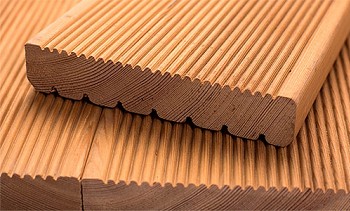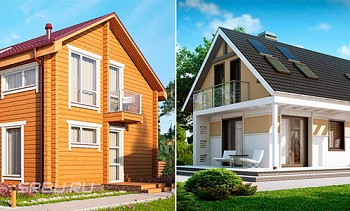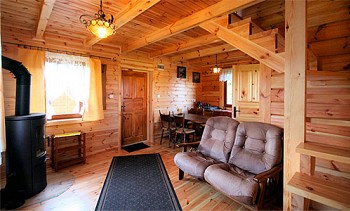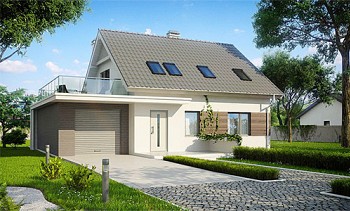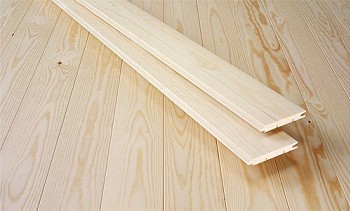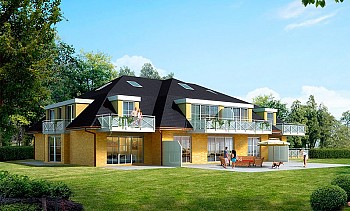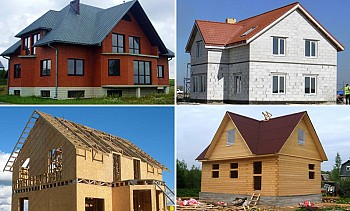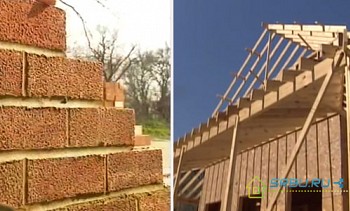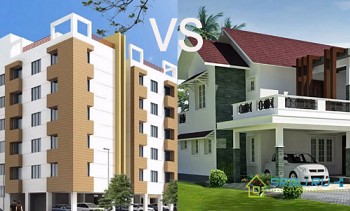What material to choose for the construction of a wooden house
Houses built of wood, with the advent of new building materials, still do not lose their relevance. Comfortable to live in, they bring us closer to nature. Externally similar to each other, wooden houses differ in technology and manufacturing details. Many craftsmen today believe that a wooden beam is the best solution for the home. And they choose it. Others put down log cabins in the old fashioned way. Further we will consider in detail all the materials used. This will help to make a choice.
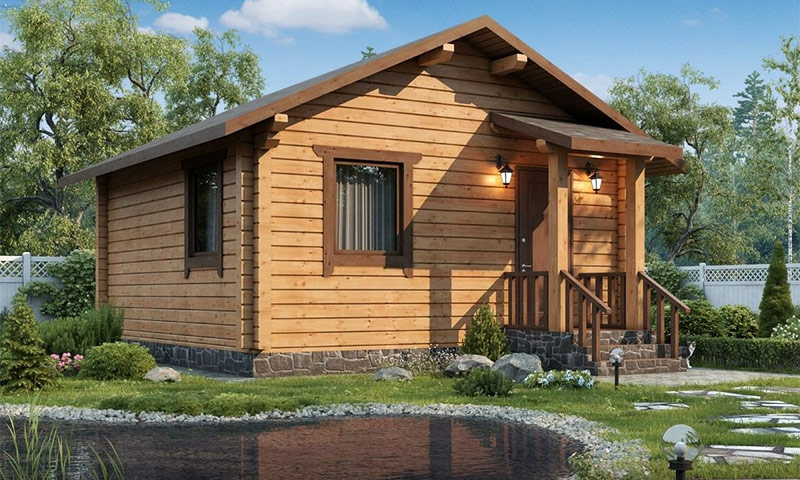
Content:
Types of materials for the construction of a wooden house
Debarked log
To obtain it, you only need to remove the bark from the tree trunk. You can do this in a classic way - using an ax. Or use a special machine, which is much faster. In this case, the fresh top layer of wood, which has not yet had time to harden and is saturated with resin, remains on the log. It resists moisture well.
The length of this building material can be different, even more than six meters. The thickness of the logs is also different, there are specimens with a diameter of up to forty-five centimeters. The structure, erected from barked logs and called in everyday life a wild log house, looks spectacular and picturesque, resembling a hut from a fairy tale. Currently, barked logs are used extremely rarely.
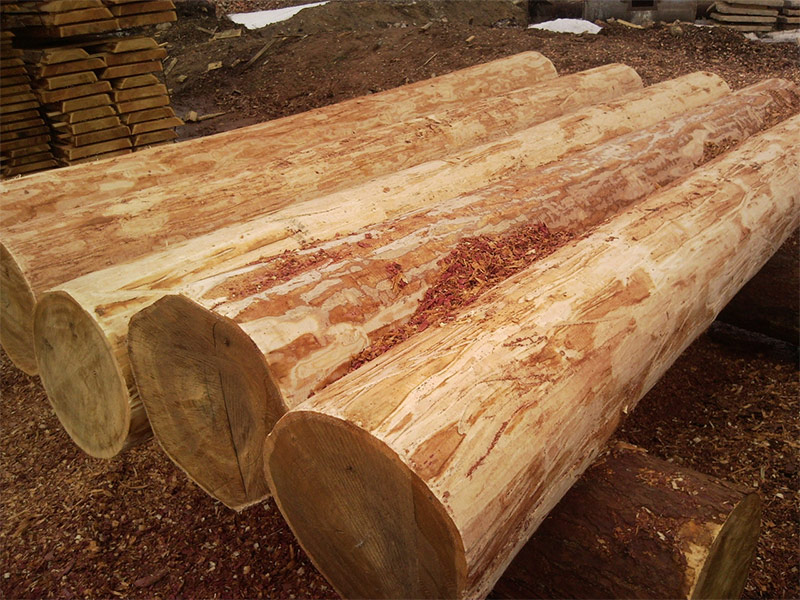
The debarked log.
The log rounded
It turns out when not only bark is removed from the tree trunk, but also part of the upper layer is about two centimeters thick. Do this using a milling machine. The result is cylinders of the same diameter (from 15 to 30 centimeters). The length of the rounded log does not exceed six meters. All elements are processed according to their location in a future building.
The given length of the logs and their unified processing (it can occur both in production and in a private way) gives strict proportions and a certain size of the same crowns, which are textured and clearly distinguished. However, such houses with log convex walls look quite classic.
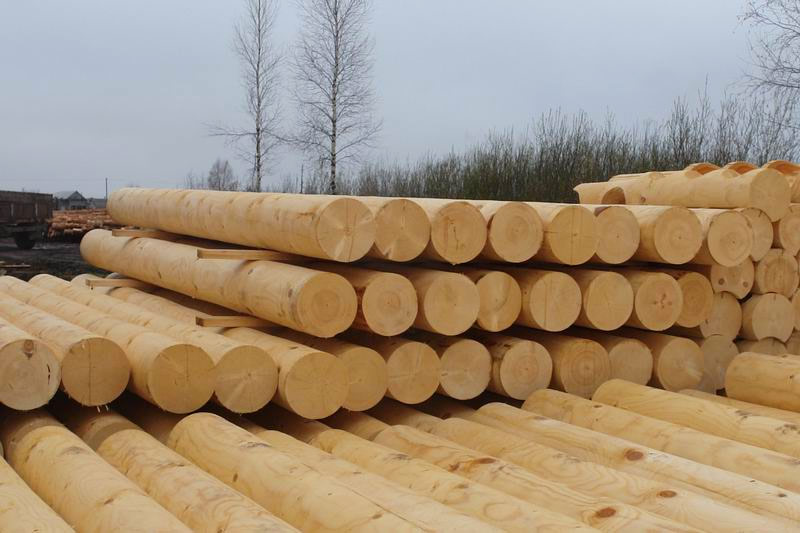
The rounded log.
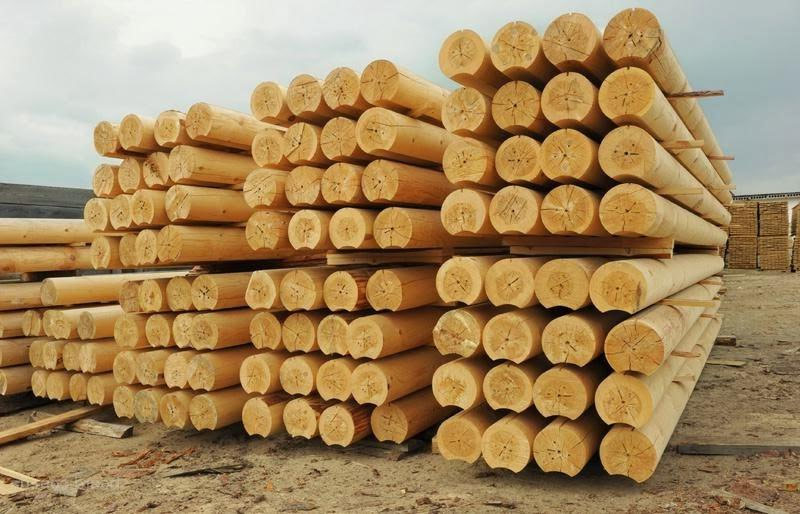
Round log with mounting groove.
Solid beam
Material is newer than a log. To obtain it, tree trunks are processed from all four sides in a production environment. Giving their cross-section the shape of a square, rectangle or semicircle (less commonly used is the so-called “D-beam”). The surface of the resulting products can be processed to smoothness, and can be left unprocessed.
For construction use a beam with a thickness of 9 to 25 centimeters. Which element to use depends on its purpose. For load-bearing structures, a greater thickness is required, for internal walls - less. To build from this material is easier than from a log, since even edges fit tightly against each other.
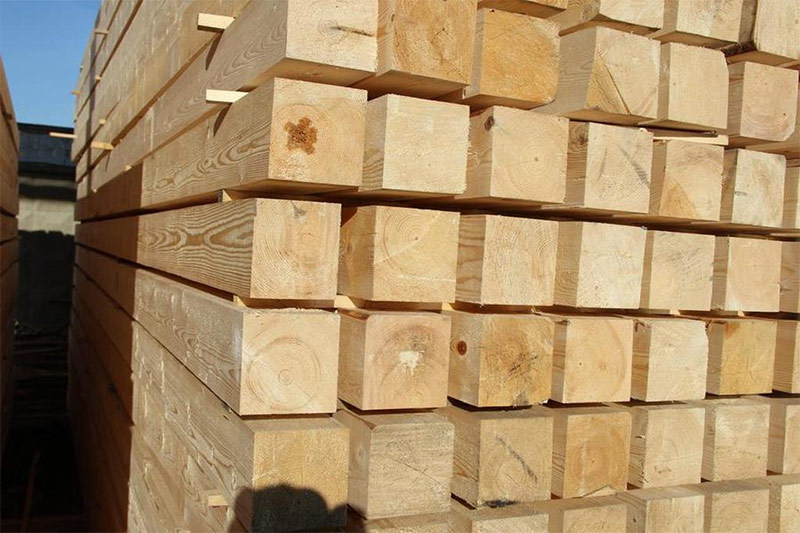
Profiled beam
Even more convenient material for construction. It also has four faces, two of which (upper and lower) are equipped with locking elements. These are recesses and protrusions made along the entire length of the beam. With their help, the parts are connected tightly (groove-tongue connection), without gaps. Not requiring additional fasteners.
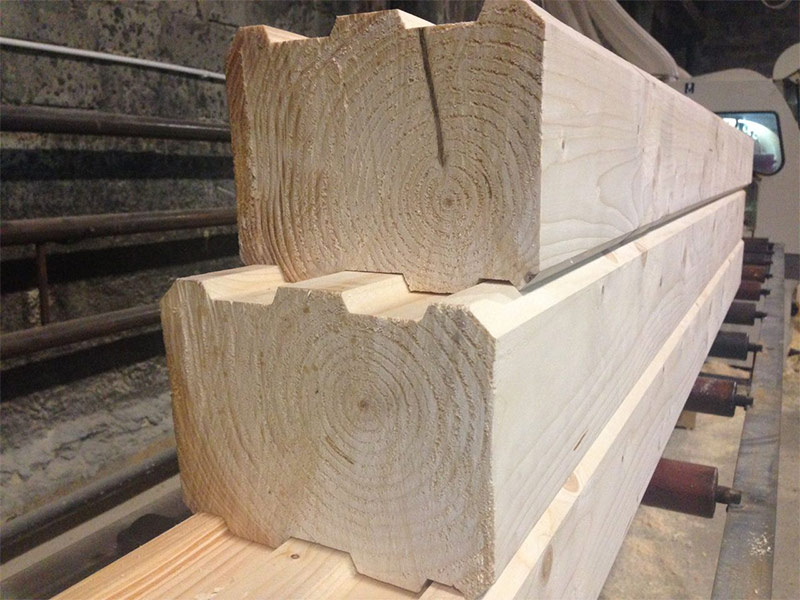 One-piece profiled beam.
One-piece profiled beam.
Glued beam
The most modern material, which is especially durable. According to this parameter, despite its wooden origin, it is even comparable to steel beams.
For the manufacture of glued beams using well-dried boards with a length of 12 meters, called lamellas.They are often made compound, assembled end-to-end on glue from several elements. Their thickness is from 7.5 to 35 centimeters. The number of lamellas in a bar can be from two to eight. Most often there are three, four or five of them.
For the manufacture of timber, the lamellas are treated with glue and placed under a press. Products of square, rectangular, semicircular or round section are produced. Glued beams are only profiled. Its surface is well processed.
Walls made of this material are strong, even and smooth. With its help, thanks to the long length and special strength of the elements, it is possible to realize original projects. For example, to build a house with huge windows or glazed walls, large spans, consoles. In such cases, there is no talk about which beam is better for building a house. Naturally, choose glued.
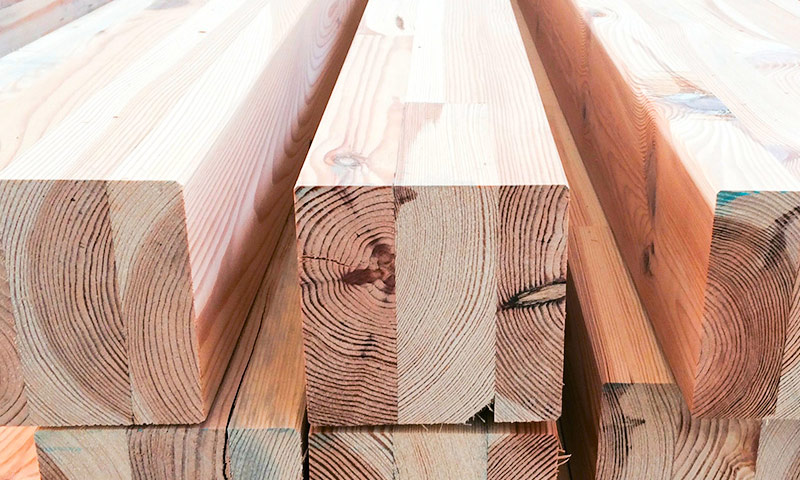
Glued not profiled timber.
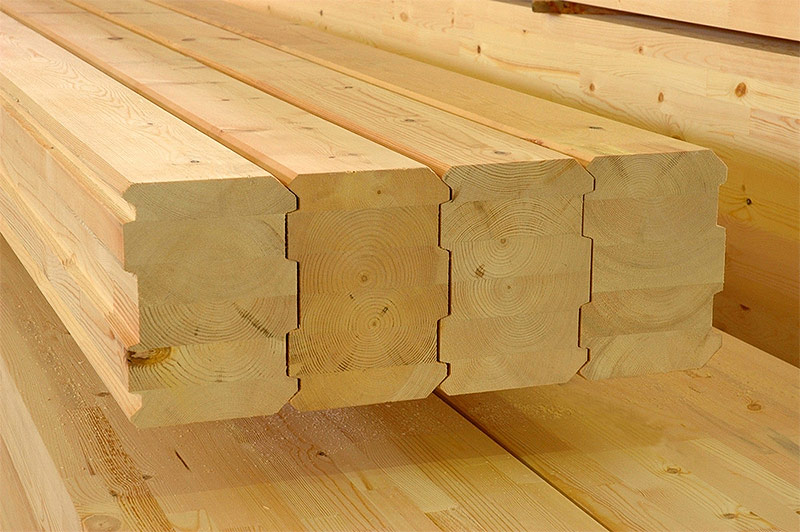
Glued profiled beam.
Comparison of wood species, their features, advantages and disadvantages
Most often, coniferous trees are chosen for wooden structures. The bug eats them less and affects the mold; they have a more even fibrous structure and lower density. The most popular materials are spruce with pine. But we will consider other breeds. By the way, it is often advisable to use several types of wood during construction. For example, for the lower part - one (more resistant to moisture), and for the upper part - the other.
General requirements that must be observed when choosing wood:
1. Bearing elements are made of the highest quality and durable material. This is selected wood, as well as first and second grade. In the contract for the supply of wood, there must certainly be a column where the variety is indicated.
2. Humidity is another significant indicator. When using an unsleeped tree, a built house can be deformed in the future, and then even collapse. A tree that has just been cut has a moisture content of 80 to 100 percent. For different buildings there is a different humidity limit:
- For a wildhouse during the construction process, it is from 30 to 40 percent. In a year (two) this indicator becomes much less - from 20 to 25 percent.
- The logs and timber should have a moisture content of no higher than 21 percent. For this, the material must be aged for at least a year in natural conditions (on the street under a canopy).
- The lowest humidity for glued beams is from 12 to 15 percent. This is due to the use of pre-dried lamellas.
Pine wood
The color of the material is yellowish red. The texture is striped. At first the tree is lighter, over time it darkens. He has dark and traces of knots that stand out noticeably from the general background. As a result, the unpainted pine product looks quite motley. The healing and pleasant aroma of pine needles in the pine house lasts a long time.
The density of this soft material is 520 kilograms per cubic meter. Wood is extremely easy to process. But she is afraid of water, therefore, it is imperative to provide a protective coating. From pine you can make any design.
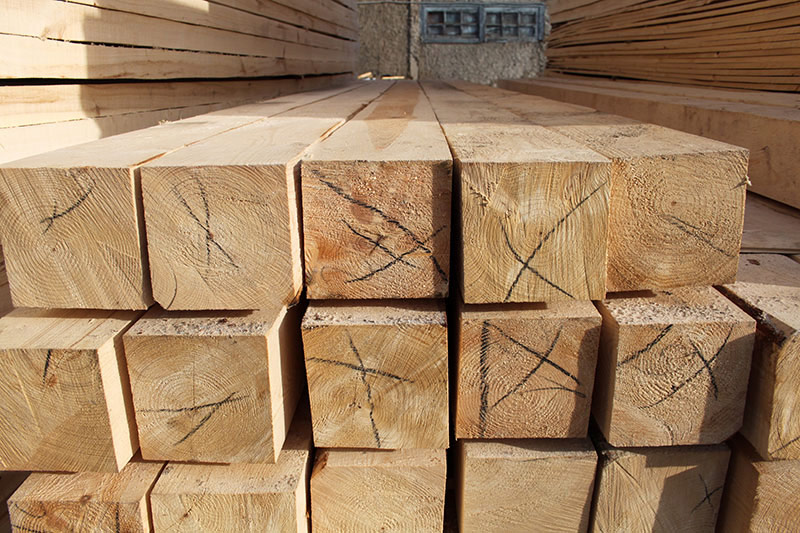
Spruce wood
Here the texture is completely homogeneous, there are practically no traces of knots. The light, almost white shade of the tree does not change over time, unlike pine, its color. The density of the material is 450 kilograms per cubic meter. What makes it one fifth “warmer” than pine. But the processing of spruce is somewhat more complicated.
This material is quite resistant to water, gives a slight shrinkage, does not crack and does not lose shape. It is advisable to use it for a "wild log" (even in a humid climate), it is also well suited for the production of glued beams. The seams between the spruce crowns are practically invisible.
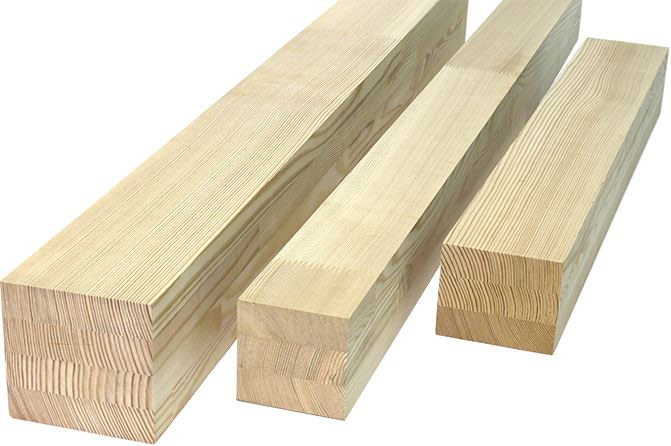
Cedar wood
Her hue is pinkish, the density is low (420 kilograms per cubic meter). The walls of the house made of cedar are one of the warmest. In addition, the material is well processed, not susceptible to rot and pests.This is due to the large number of essential oils, which are also useful for creating a favorable indoor microclimate.
From cedar, you can build any home. But its wood is quite expensive, so various furnishings are most often made from it. As for houses, it is used for the construction of wild log cabins.
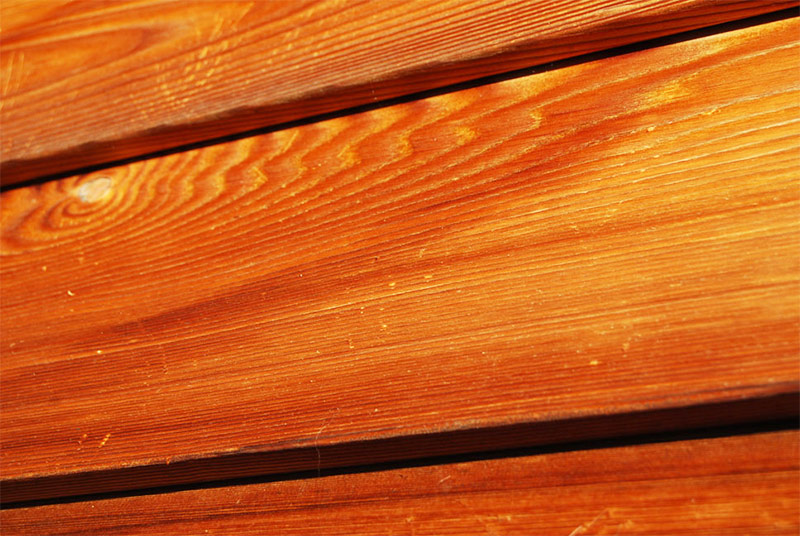
Larch
The structure of the material is striped, the color is brown-red. Due to the content of strong antiseptics, the wood is perfectly stored (but it is imperative to remove the sapwood). It has a high density (680 kilograms per cubic meter), solid, difficult to process, holds heat worse by a third than pine.
Due to its high moisture resistance and hardness, this material is often used for those parts of the house that are exposed to water. In particular, the bottom of the walls. They also build larch houses in humid climates.
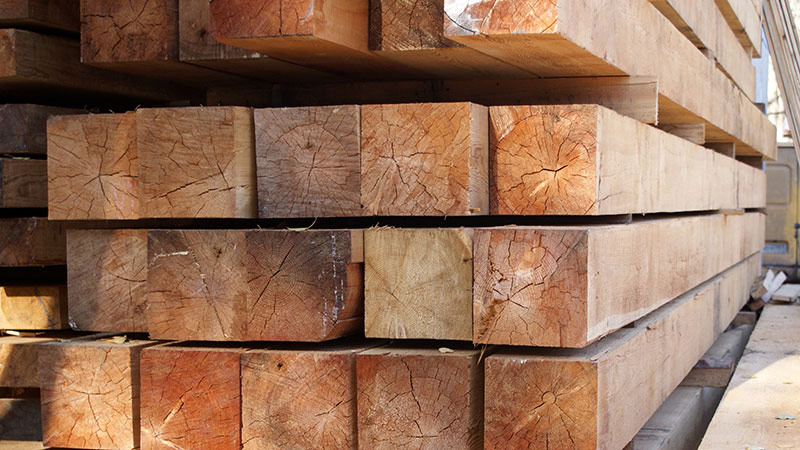
Fir wood
The light shade of the material has slightly pronounced stripes. Fir does not smell of resin at all, without protective treatment it can rot. Her density is low (from 375 to 425 kilograms per cubic meter), there is almost no shrinkage. Processing this tree is very easy. It is used for shingles and rafters, as well as the construction of log cabins in a dry climate.
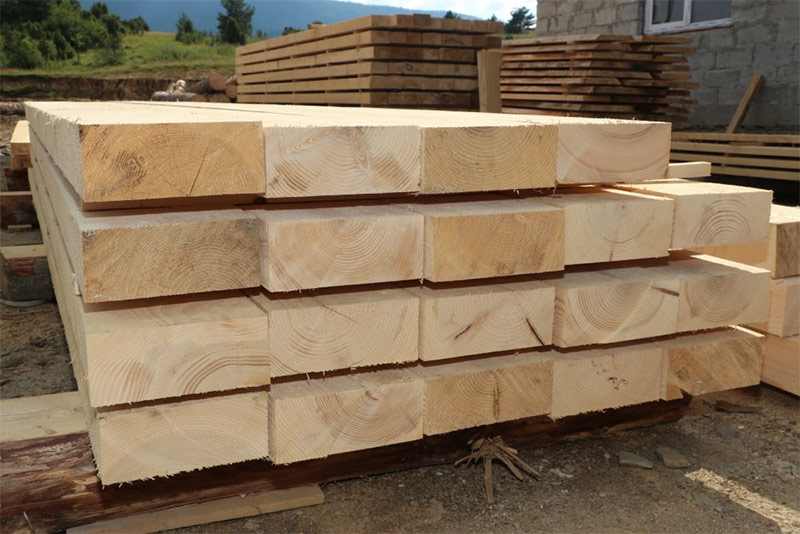
Features of the technology of building a wooden house from various materials
Next, we compare the difference between the construction of a wild and rounded log house, as well as a house made of timber. This will help you quickly find out which is better - a house made of timber or logs. But first, let's touch on some important things.
On a note:
- Thick logs are harder to dry. Because of this, their surface may crack (the log will dry out on the outside and remain damp inside). To avoid this, make cuts for the entire length of the product. And it is better not to take material with a thickness of more than 25 centimeters.
- Good alignment of corners is the key to maintaining heat. The house, built on the type of wild log house, best perceives the Canadian or Norwegian junction "in the bowl." Moreover, during shrinkage due to jamming of the logs, no cracks are formed. But the Russian "bowl" is invariable shrinkage cracks that have to be caulked with hemp or bast jute.
- When choosing a glued beam, one should know that gluing can be horizontal (with lamellas and seams horizontally located) or vertical (with a vertical arrangement of seams and lamellas). In the first case, the material passes air well and is suitable for building walls. The vertical version is more moisture resistant, and it is also more resistant to bending. It is good to make rafters and load-bearing beams from such a beam.
And now - directly about technology. Each of them involves the assembly of the "dry" type of large parts. It takes several months and can be carried out both in the warm and in the cold season. Differences in technology are dictated by the material of manufacture.
Wild log cabin
Logs for him take a thickness of 30 to 45 centimeters. They may be slightly thinner at the ends than in the middle, and slight curvature is allowed. Rafters and walls inside the house require thinner (from 15 to 20 centimeters) material. Work is carried out manually, so this method takes the most time. Builders performing this difficult task should be experienced, giving a guarantee on the work.
The tree is used quite wet, so often to achieve a good result, the lower part (first crowns after the foundation) is performed in a special way. For example, take thicker logs or more moisture-resistant wood (oak, larch). During operation, additional processing of certain areas is necessary (where there are locks, joints of crowns). Seal these places with moss, jute or tow so that there are no gaps.
Providing inevitable shrinkage, make sliding joints between the rafters and the wall. When the box is erected at home, it is necessary, after opening all the openings, to wait at least a year (until the humidity returns to normal, and the walls shrink). If the walls are thick, then you have to wait a year and a half. After that, you can work on - shrinkage will be, but much less.For windows and doors, sliding casing-type slats are used, all the cracks are caulked, the house is finished and inhabited.
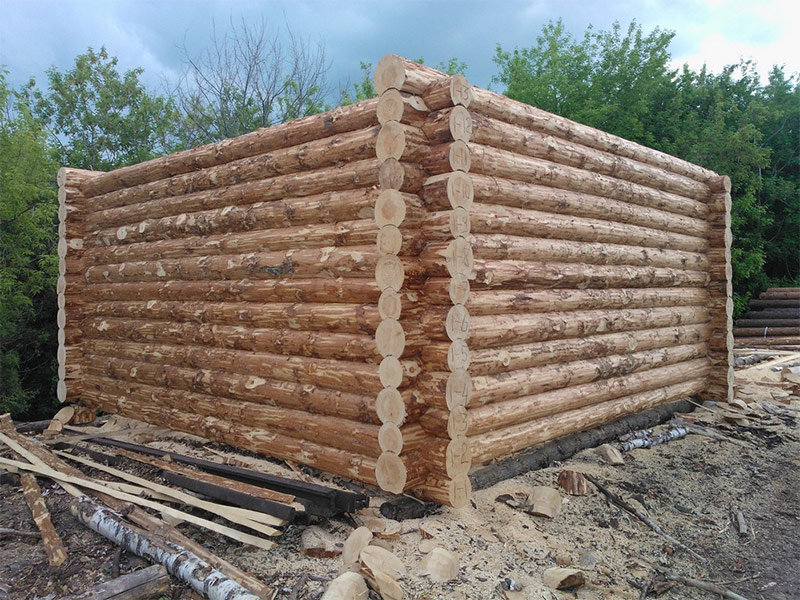
Log house
Thin logs are used here - from 15 to 25 centimeters in diameter. Building a house is much easier than in the previous case. All elements are already fitted to each other, ready-made kits are sold. Due to their seasoned size and smooth surface, the parts fit well, without gaps.
Shrinkage in such a house is small (for several years from 6 to 8 centimeters by 3 meters in height). So do not need a break for her. And special jacks-compensators generally eliminate its influence. The main thing is not to forget to tighten them on time. In order not to blow, a jute or linen twine is laid outside between the crowns.
It happens that over time, small cracks appear in the logs. However, the house will not become less strong from this. Note that it is best to build such a house in the factory, entrusting the entire process to professionals.
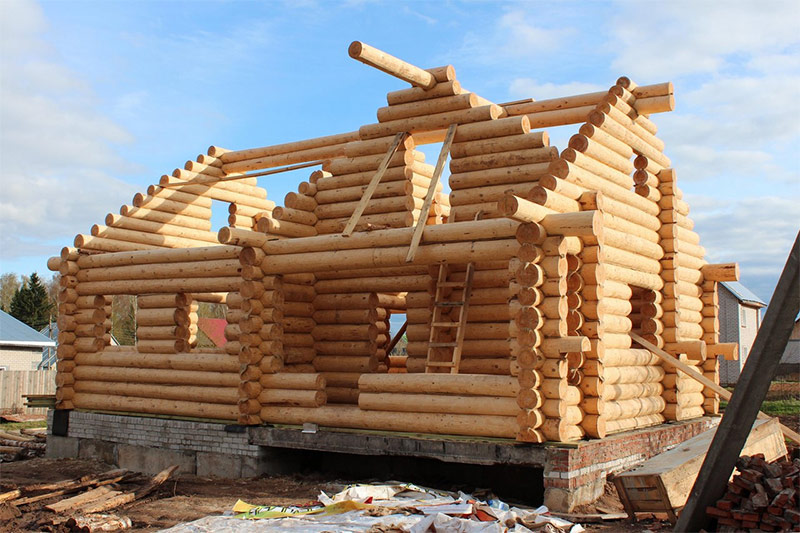
Solid timber house
Walls of this structure are usually made with a thickness of 18 to 22 centimeters. And the partitions are thinner - from 9 to 12 centimeters. They build either on their own (by purchasing a set of materials), or order a kit with assembly at the factory. It is much more convenient, simpler and more reliable to build from a profiled beam. Between the profile ledges perfectly fits the seal, which is placed between the crowns.
Shrinkage is extremely small (it is 3 meters in height from 3 to 6 centimeters). The appearance of small cracks is not a danger. Break in the construction do not.
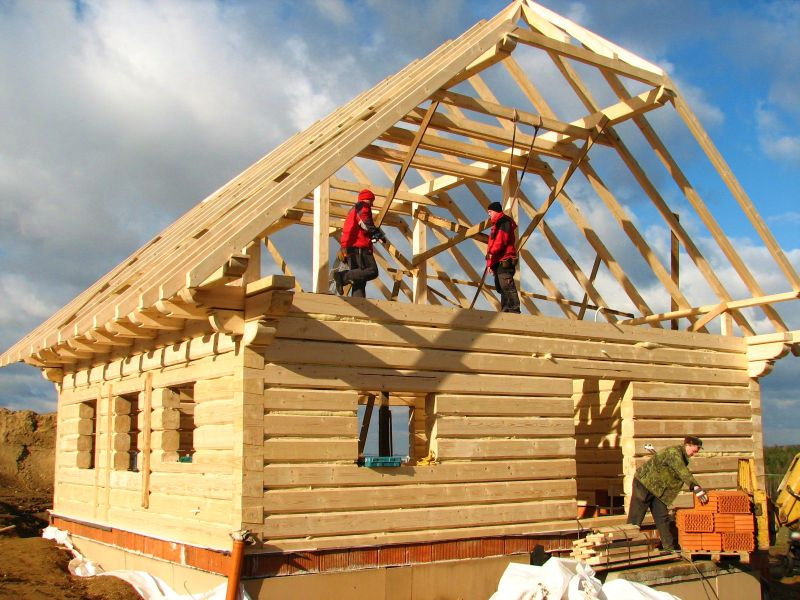
Laminated Timber House
The material is used with a thickness of 9 to 33 centimeters. Construction is the fastest (especially if it is carried out by professionals in the workplace). There is practically no shrinkage - no more than 2 centimeters (after all, the tree is used dry). Cracks neither in the beam itself, nor between the crowns does not appear.
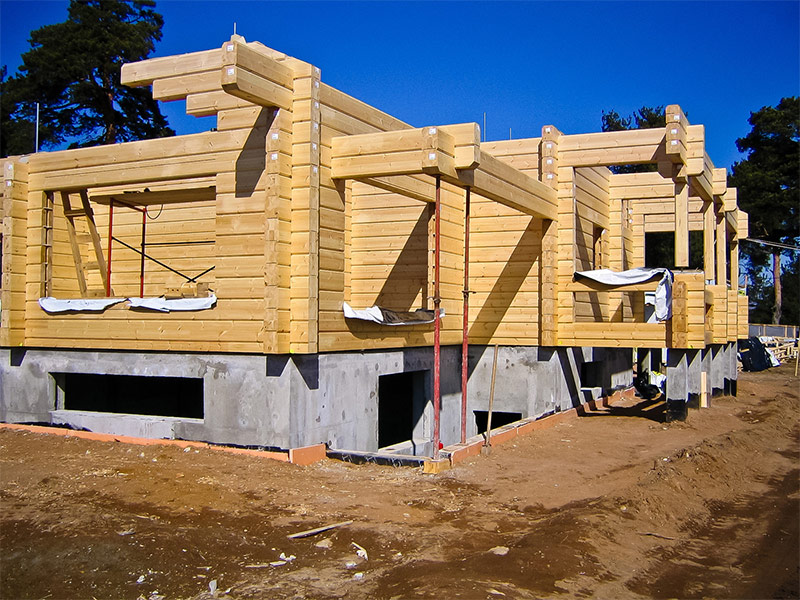
What material is better for building a wooden house
And now, in several respects, we will compare all these buildings. To decide which is better - a rounded log or a profiled solid beam, or a rounded log or glued beam.
Heat preservation
Ideally, to comply with existing standards, a wall made of wood should be 35-40 centimeters thick, and also without a single crack. None of our material gives this.
A wild log house has logs of different thicknesses along the length (where the joint of the crowns is thinner). We need the right sampling at the joints, sealing gaps, the use of a sealant. In this case, we will achieve a normative result only in a house with walls no thinner than 40 centimeters. The firs or cedar walls are warmest.
The rounded log has a thickness of up to 25 centimeters, without insulation they will be too cold. A heater is laid on the roof with a layer of 40 centimeters, windows are energy-efficient, crowns are sealed with a sealant, building envelopes are insulated.
A timber house (especially from profiled elements) due to the uniform thickness of the walls holds heat better than a log house. But additional insulation measures are needed too.
Laminated timber is 20 percent better at keeping heat than normal. The technology allows the use of timber of greater thickness. But warming is also necessary.
Taking the same wall thickness, you can find out that the warmest is glued beams. Next, in order to reduce heat efficiency, there is a profiled beam (not glued), an ordinary beam, a log.
Durability of the building
The main enemy of wood is water. The life span of a home depends on its degree of protection against water. In particular, a high base will help from groundwater, from the rain - the removal of the roof over a long distance, from the fumes inside - good ventilation.
It is more difficult to protect against atmospheric moisture. At first (the first years), the resin contained in the wood protects, but then measures must be taken (treated with antiseptics).
Wherein:
- The wildhouse needs special care - after all, the sapwood strongly absorbs water.
- Rounded logs and timber are often treated with an antiseptic in production.
- Glued beams do not need any processing. It is also processed at the factory (each panel).
Environmental friendliness
All considered types of houses are initially environmentally friendly, because wood is a natural material. However, when finishing work, this environmental friendliness can be spoiled. If using materials containing toxins. Therefore, one must be extremely careful about their choice - materials of different quality are sold on the market.
Erection speed
The fastest way to build a house is from a profiled beam (especially when ordering a ready-made kit, assembled, like a designer). The slowest way to build a wild log cabin.
The appearance of the building
All buildings made of logs or barked logs, as well as timber, are usually of a classic look. but the use of glued beams allows you to build buildings in various architectural styles.
Construction cost
The cost will depend on many factors, such as the type of material, its thickness and the area of construction. But ceteris paribus, the cheapest house will cost a house made of logs. A little more expensive will cost a house from a solid profiled beam. Next in terms of value will go a wild log house, because although the material itself will cost less than all analogues, however, its construction will require a lot of manual, skilled labor. The most expensive will be the construction of profiled glued beams.
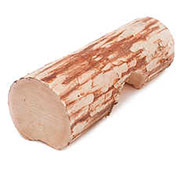 | 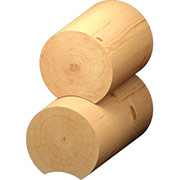 | 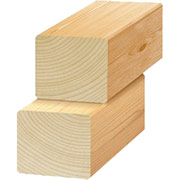 | 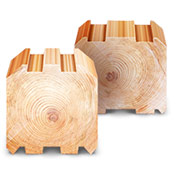 | 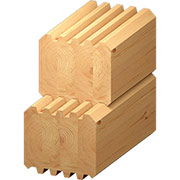 | |||||||
|---|---|---|---|---|---|---|---|---|---|---|---|
| Debarked log | The log rounded | Solid bar, unshaped | Profiled solid beam | Profiled glued beam | |||||||
| Manufacturability | low | average | average | high | high | ||||||
| Thermal insulation | low | low | average | average | high | ||||||
| Moisture and biostability | low | average | average | average | average | ||||||
| Strength | low | low | average | average | high | ||||||
| Environmental friendliness | high | high | high | high | average | ||||||
| Durability | average | average | high | high | high | ||||||
| The appearance of the building | classical | classical | classical | classical | various architectural forms allowed | ||||||
| Erection speed | slow | average | average | quick | quick | ||||||

